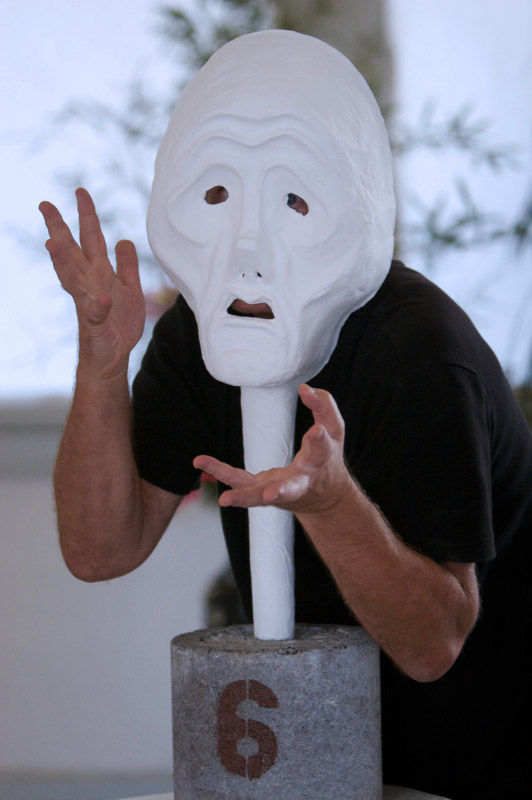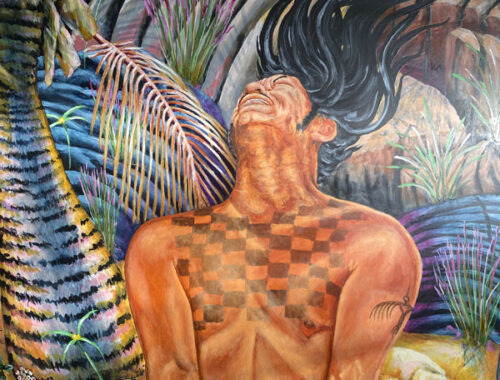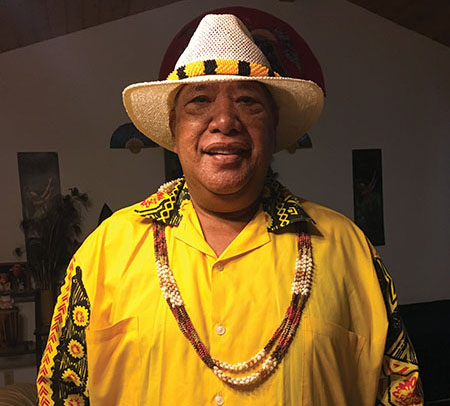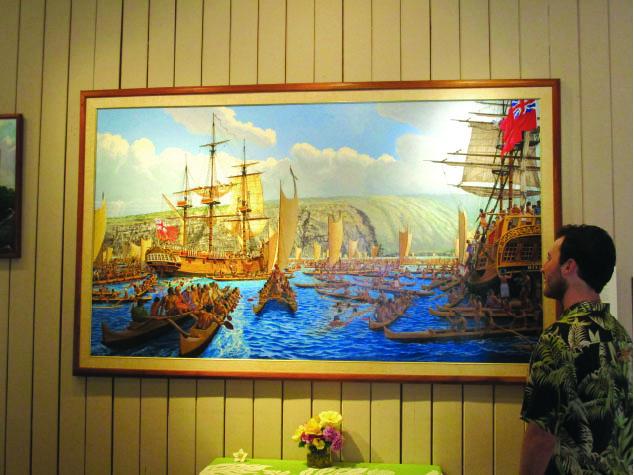
Exceptional Art for an Exceptional Community
 Hawai‘i Preparatory Academy’s Isaacs Art Center
Hawai‘i Preparatory Academy’s Isaacs Art Center
By Catherine Tarleton
The Herb Kawainui Kāne painting is what draws me in. From the front door of the Isaacs Art Center, “Cook Landing at Kealakekua Bay” is like a window I need to look through. There must be hundreds of people in this painting. I walk up to it, into it, meeting the canoe passengers in the foreground: the elder in kapa with tattooed face, paddlers in malo, smiling women with feather lei and kukui nuts. A chanter greets Discovery, his companion holding a black pig. English sailors in the rigging on Resolution, watching, pointing; officers clumped in conversation on deck. Swimmers in the water, canoes, too many to count, all the way to shore.
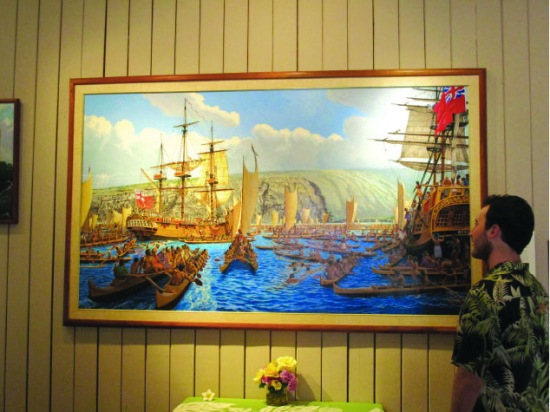
I know that Herb Kāne (1928–2011) was a voyager himself. That means the million details are perfect. This artist knows the smell of the ocean and the feel of the wind at Kealakekua, the exact color of the water and the lava. He would know the tattoo and kapa patterns, the correct lashing, rigging, construction of the ships. Years and years and years of research, of experience, guide his brushes. And great love. This is more than a painting. A wind-cooled tear slides down my face.
Stepping back, turning around, I’m surrounded by what Isaacs Art Center Director Mollie Hustace calls “exceptional art.” I’m amazed by the center’s variety of past and present, its eclectic cohesiveness. Somehow it is perfect for Waimea, a sweet fusion of realist landscapes, Chinese and Japanese pottery, sleek koa furniture, magnificent Ni‘ihau shells, all contained in a 102-year-old former schoolhouse.
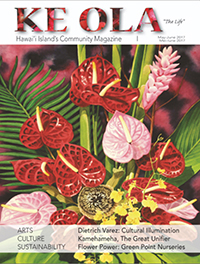
On one wall, an original engraving by John Webber from the atlas of the Third Voyage of Captain Cook, circa 1784. Nearby are vivid contemporary paintings by Jean Charlot, and Hon Chew Hee. In the next room, an intimate Harry Wishard valley landscape, and a 19th Century Jules Tavernier painting of Kīlauea on a wooden plate. A dazzling black and crimson quilt shares space with stunning woodworks, an intricate koa platter by Tiffany and Timothy Shafto with painting by Robert Jones, and trompe l’oeil bowl masterfully basket-textured by Gregg Smith. Other artists represented include Helen Thomas Dranga, Cornelia MacIntyre Foley, D. Howard Hitchcock, Helen Kelley, John M. Kelly, Hajime Okuda, Shirley Russell, William Twigg-Smith, Lionel Walden and Theodore Wores.
A retail art venue supporting Hawai‘i Preparatory Academy’s scholarship program, the Isaacs Art Center opened in 2004 and is itself a work of exceptional art. It has grown from a spinoff of the school’s successful Scholarship Auction into a place for collectors, for community, and for keiki too. Filling its role as an education resource, the Center hosts classes not only in art, but in history, Hawaiian studies, language arts and music.
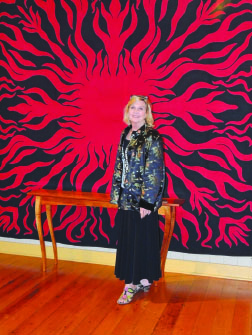
“We showcase the most distinguished artists and some of the most exceptional art of Hawai‘i,” says Mollie, who also teaches art history at HPA. “Their works reflect a strong commitment to mastery of artistic skills and development of personal style.”
“We principally focus on major 19th- and 20th-century movements, such as the Volcano School and Hawaiian Modernism, but also present an annual showcase of contemporary Big Island wood artists,” she says. “Like Gauguin’s experience in Tahiti, trained artists came here in pursuit of a different life and found new inspirations. Through their work, they contributed to the story of art in Hawai‘i—a story that culminates in today’s emerging artists.”
As I walk toward the far room, it’s hard not to look past the quieter historic works to the explosion of color, dizzying in contrast to Herb Kāne’s exacting detail. Huge, swirling images of ochre-skinned women doing simple things: making lei, hanging dresses.
“This exerts a gravitational pull to it,” says HPA alumnus, Class of 2012, Justin Sandulli, referring to an enormous painting, “Lei Queen Fantasia” by Madge Tennent (1889–1972). Justin wrote his undergraduate thesis on Tennent for Duke University and is presently Curator of Special Exhibitions with the Center.
“It hypnotically pulled me toward it, and it was kind of a spiritual awakening,” Justin says. “She is one of the most consequential artists in Hawai‘i… Words can’t do her work justice. It expresses life from within; it has an internal glow.”
Madeline Grace Cook was born in England and at a young age moved with her family to South Africa. Recognizing her artistic talent at a young age, her parents moved the family to Paris so that she could study with William Bouguereau. At age 12, she placed fifth in a juried academy show. Returning to Capetown, Madge met and married Hugh Tennent, and traveled to New Zealand and Sāmoa where they lived for six years and raised two sons. In 1923, en route to London to enroll the boys in an English school, they stopped over in Honolulu for a three-day holiday—and never left.
“When she came along it was such a shock,” says Justin. “At the time, most artists were expressing the natural wonders of Hawai‘i in landscapes. And in landscapes, people just populate the scene. Madge is expressing the spirit of Hawai‘i through its people, especially these large women.”
“I have built my Hawaiian figures in art, in the manner of building a cathedral,” Madge wrote in her Autobiography of an Unarrived Artist. “Cathedrals are built slowly, and the people who build them seldom experience the joy of seeing their life work completed, but are sustained only by the instinctive faith that their work is important and beautiful.”
Justin continues, “She is the most famous artist ever to have worked in Hawai‘i. The international art community loved her.” Indeed her work has appeared in major museums and exhibits worldwide, including the 1939 New York World’s Fair, the opening exhibit of the National Gallery for Women in the Arts in Washington, DC, the H.M. de Young Museum in San Francisco, the Victoria and Albert Museum in London, Honolulu Academy of Arts, and the University of Hawai‘i.
Today, however, more than anywhere else in the world, Madge’s work lives in Waimea, in the Isaacs Art Center. How that came to be began in 1974 with the first HPA Scholarship Auction.
“I had so little money to give for scholarships,” says Bernard Noguès, former HPA Admissions Director and Financial Aid Officer. “There was a school in Honolulu, now called La Pietra: Hawai‘i School for Girls, that put on the first large fundraiser dinner and auction for a cause. They did it in Honolulu in 1972 or ’73, and I knew some parents and friends who went, and I had the idea we could do something like this here.”
Renowned Waimea rancher Anna Lindsey Perry-Fiske supported the auction in a big way. “Anna lent her name and energy,” says Bernard. “We held the auction in the Batik Room [at Mauna Kea Beach Hotel]. It was a superb location. We used to be able to cram 222 people in the room, on long tables. We were packed like sardines, but when you are very close to others, there’s a sort of chemistry that develops. It adds to the excitement.”
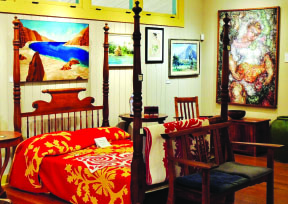
Bernard said that first auction raised $29,000, five times what he had for scholarships before. In 2007, it achieved $705,000.
“We really built it up to the biggest auction in the state of Hawai‘i,” Bernard says. “Many great painters of the early 20th century were represented. It made it a place you wanted to come—not only to help HPA, but to see art and find things you don’t see anywhere. It also generated a lot of interest in the school, and made a huge difference in trying to establish a Financial Aid Program.”
The tradition continued for more than 20 years. Along the way, HPA began conversations about a permanent art gallery on campus. Serendipitously, in 2002, members of the Waimea Preservation Society and Waimea Community Association visited Bernard. They were attempting to save the original Waimea Elementary and Intermediate School’s “Building N,” built in 1915. Bernard and others raised $700,000 in restoration costs in a unique way. Building N was originally divided by pocket doors into seven classrooms. Once revitalized, these became seven of what Bernard called “naming opportunities.”
“I was looking for people to support the project financially,” says Bernard. “We asked some people to give $50,000 or more to have a room named for them. One room is named in honor of the Dillingham family, class of ‘66. Every room has a name.” Seven rooms at $50,000 covered half of the total. The second half was financed by George and Shirley Isaacs, for whom the Center is named.
Bernard continues, “George Isaacs had a son with us, George, Jr., in the 70’s. That was his connection with the school. He and wife Shirley worked hard for many years and built a large real estate company… They would lend their house on Kahala Avenue so we could invite people there to be interviewed—imagine the impression! They organized parties for alumni, and were very, very, very supportive of the school from way back.” A noted art collector, George also shared his treasures to help get the Center started.
The 5,580-square-foot structure was carefully moved in sections to its present location. After an 18-month restoration, the Isaacs Art Center opened in 2004, earning a Preservation Honor Award from the Historic Hawai‘i Foundation and a listing on the State and National Registers of Historic Places.
The following year, as a result of the established relationship between Bernard and the Tennent family, conversation began about the possibility of transferring the care of the Tennent Foundation Collection to HPA. One year later, the transfer of 80+ paintings and works on paper was accomplished and Madge’s work had a new home.
As I look through these rooms, I think of their benefactors. I imagine that the Crespis, Dillinghams, and Saalfelds, Michael Berolzheimer, Joyce Benfield, Martha L. Greenwell and the Burklands—and George and Shirley Isaacs—must be very pleased with their investments in the Isaacs Art Center.
I stop again at the Kāne painting of Kealakekua on the way out. To the right are the rounded, sepia-toned women of “Hawaiian Three Graces” by Madge. Except for the obvious aloha in the artists’ work, there is nothing at all similar about these two paintings. But hanging together here, they make a most interesting marriage. Then I remember: Madge’s maiden name is Cook. I wonder if Herb Kāne borrowed Madge’s opulent wahine for his canoe. I wonder if Madge knows she built her cathedral.
The Isaacs Art Center is open 10am to 5pm, Tuesday through Saturday. Admission is free. For more information, call 808.885.5884 or visit their website. ❖
